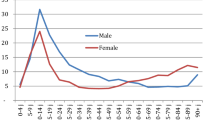Abstract
Purpose
Self-cutting injuries have a low mortality rate, but this type of injuries has special clinical significance because they have the potential of leading to devastating disability and repeated suicide attempts. The purpose of this study is to analyze the nature and outcomes of wrist-cutting injuries.
Material and method
A retrospective study was designed in order to investigate 41 suicide attempts by wrist cutting attended to Uludag University Faculty of Medicine Emergency Department between June 2008 and December 2014. The patients were analyzed for age, gender, alcohol intake, psychological state, prior suicide attempts, and clinical features such as injury side, injury pattern, and used tool.
Results
It was seen that the severity of wrist-cutting injury variates between gender and age.
Conclusion
Alcohol or drug consumption and having a diagnosed psychiatric disorder create a higher risk for extensive wrist lacerations. It was seen that skin only lacerations were most likely to repeat the act and therefore are most in need of psychiatric intervention.
Level of evidence
Level III, retrospective study.



Similar content being viewed by others
References
http://www.who.int/mental_health/prevention/suicide/suicideprevent. Accessed 2 Sept 2008.
Reuhl J, Lutz FU. Suicide in a large West German city (1985–1989). Versicherungsmedizin. 1992;44:13–5.
Fukube S, Hayashi T, Ishida Y, Kamon H, Kawaguchi M, Kimura A, et al. Retrospective study on suicidal cases by sharp force injuries. J Forensic Legal Med. 2008;15:163–7.
Jaquet JB, van der Jagt I, Kuypers PD, Schreuders TA, Kalmijn AR, Hovius SE. Spaghetti wrist trauma: functional recovery, return to work, and psychological effects. Plast Reconstr Surg. 2005;115:1609–17.
Yii NW, Urban M, Elliot D. A prospective study of flexor tendon repair in zone 5. J Hand Surg (Br.). 1998;23:642.
Graff H, Mallin KR. The syndrome of the wrist cutter. Am J Psychiatry. 1967;146:789–90.
Pao PE. The syndrome of delicate self-cutting. Br J Med Psychol. 1969;42:195–206.
Rosenthal RJ, Rinzler C, Walsh R, et al. Writs–cutting syndrome: the meaning of a gesture. Am J Psychiatry. 1972;128:1363–8.
Simpson MA. The phenomenology of self-mutilation in ageneral hospital setting. Can Psychiatr Assoc J. 1975;20:429–34.
Fujioka M, Murakami C, Masuda K, Doi H. Evaluation of superficial and deep self-inflicted wrist and forearm lacerations. J Hand Surg. 2012;37:1054–8.
Eisenberg TL, Glysch RL, Remington PL, Katcher ML. Youth suicide in Wisconsin: mortality, hospitalizations and risk factors. WMJ. 2005;104(7):54–8 (69).
Kapandji A. Clinical test of apposition and counter-apposition of the thumb. Ann Chir Main. 1986;5(1):67–73.
Bukhari AJ, Saleem M, Bhutta AR, Khan AZ, Abid KJ. Spaghetti wrist: management and outcome. J Coll Physician Surg Pak. 2004;14:608–11.
Schmidtke A, Bille-Brahe U, DeLeo D, Kerkhof A, Bjerke T, Crepet P, et al. Attempted suicide in Europe: rates, trends andsociodemographic characteristics of suicide attempters during the period 1989–1992. Results of the WHO/EURO Multicentre Study on Parasuicide. Acta Psychiatr Scand. 1996;93:327–38.
Kemperman I, Russ MJ, Clark WC. Pain assessment in self-injurious patients with borderline personality disorder using signal detection theory. Psychiatry Res. 1997;70:175–83.
Bohus M, Limberger M, Ebner U, et al. Pain perception during self-reported distress and calmness in patients with borderline personality disorder and self-mutilating behavior. Psychiatry Res. 2000;95:251–60.
Hayton M. Assessment of hand injuries. Curr Orthop. 2002;16:246–54.
Ong SG, Fung SC, Chow SP, Kleevens JW. A study of major factors associated with severe occupational hand injury in Hong Kong island. J Soc Occup Med. 1982;32:82–8.
Beaton AA, Williams L, Moseley LG. Handedness and hand injuries. J Hand Surg Br. 1994;19:158–61.
Klonsky ED. The functions of deliberate self-injury: a review of the evidence. Clin Psychol Rev. 2007;27:226–39.
Runeson B, Tidemalm D, Dahlin M, Lichtenstein P, Langstrom N. Method of attempted suicide as predictor of subsequent successful suicide: national long term cohort study. BMJ. 2010;341:3222.
Author information
Authors and Affiliations
Corresponding author
Ethics declarations
Conflict of interest
Burak Ersen, Orhan Tunali, Ramazan Kahveci, Ismail Aksu, and Mehmet Can Saki declare that they have no conflict of interests.
Funding
None.
Consent
For this type of study, formal consent is not required. Only written informed consent was obtained from the patient for publication of this accompanying image.
Ethical standards
This study has been approved by the appropriate ethics committee and has therefore been performed in accordance with the ethical standards set forth in the 1964 Declaration of Helsinki and its later amendments.
Rights and permissions
About this article
Cite this article
Ersen, B., Kahveci, R., Saki, M.C. et al. Analysis of 41 suicide attempts by wrist cutting: a retrospective analysis. Eur J Trauma Emerg Surg 43, 129–135 (2017). https://doi.org/10.1007/s00068-015-0599-4
Received:
Accepted:
Published:
Issue Date:
DOI: https://doi.org/10.1007/s00068-015-0599-4




